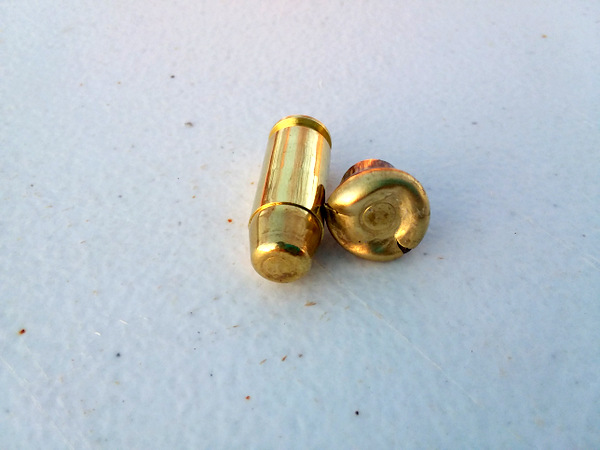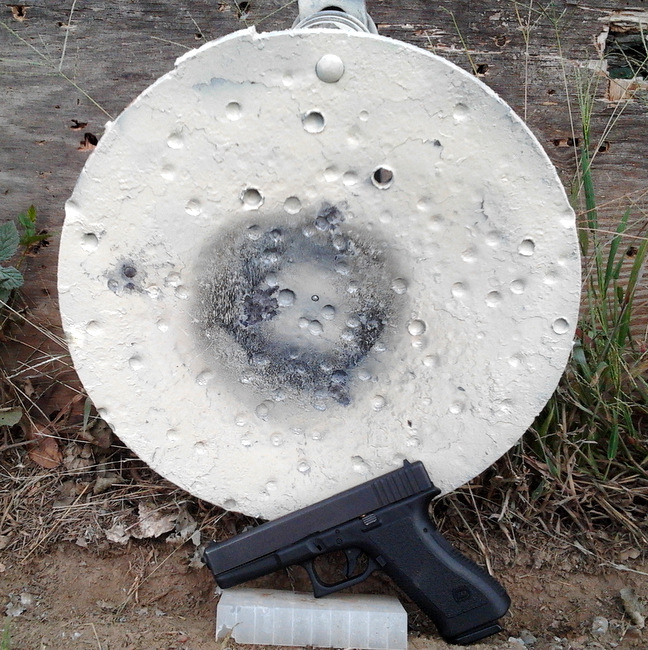The .40 S&W- Your Tax Dollars at Work!

Remington’s 180 grain UMC load, riveted to over 45 caliber after passing through two gallons of water and driving an inch into a phone book. Can you say Military Service Load?
The .40 S&W cartridge generates a lot of emotion. 9mm guys see it as a beast of biblical propotions. It has been referred to as a hard-kicker and an ‘Answer in search of a question.’ I have seen it ridiculed as inaccurate, or because no SAAMI ‘Plus P’ standards exist for it. I have even had a little fun at the .4o S&W’s expense, myself.
When the cartridge was introduced in 1990, I was the Sgt. and ‘firearms guy’ for a rural MO Sheriff’s Department. When a deputy would rave about their new .40 S&W, I would politely ask to see an example of the wondrous new invention. While they were thumbing a round from a magazine, I was clearing my Ithaca 1911 and locking the slide open. I would then hold my pistol with the barrel pointed skyward and drop their entire .40 cartridge, nose down, through the barrel of my 1911. As it dropped out the ejection port and landed on my desk, I’d say “Looks like they made it a little undersized; believe I’ll just keep what I’ve got.”
Despite my early disinterest in this cartridge, it is a sound concept. The .38-40 Winchester broke ground for it in 1874 and it achieved fair popularity in that firm’s rifles and the various Colt revolvers. Again in 1963, the basic concept was championed by Elmer Keith, Bill Jordan and Skeeter Skelton as the ‘ideal law enforcement cartridge’- the .41 Magnum. Their original idea of a .41 bullet, at moderate velocities, was entirely sensible. Unfortunately, it was lost in the rush to make their new .41 just as powerful as the .44 Magnum. This ‘.41 Magnum Mistake’ sort of reversed itself in 1986, but this time in a true .40 caliber. The FBI had undertaken adapting Norma’s (and Jeff Cooper’s) 10mm Auto for law enforcement use. While it handily ‘split the difference’ between the .38-40 and the .41 Magnum, it recoiled more than The Bureau liked and they watered it down. It didn’t take long for clear thinkers to realize that these ballistics could be accomplished in a shorter cartridge than the 10mm- making it tenable in mid-size service pistols. The .40 S&W cartridge was the eventual result. I finally accepted the .40 Smith & Wesson, partly because it wasn’t going away; but mostly because it just makes sense. I have used a lot of handgun cartridges over the years and I’m impressed with how well its ballistics overlaps many of them. For example:
Proponents of the 9mm cite reduced ammo costs, and suggest that the +P+ 9mm can do anything the .40 S&W can. The first argument is flattened by the fact that many .40 S&W autos can easily be converted to 9mm- but the reverse is not the case. I personally don’t think that a 147 grain 9mm does the same damage as a 165 grain .40 at the same or higher velocities; but I’ll admit to being predisposed in favor of bigger, heavier bullets.
The 125 grain .357 hollowpoint is widely thought to be the standard by which defensive pistol cartridges are judged; from packable revolvers, it achieves around 1350 fps. The .40 can match this with a larger diameter 135 grain bullet. Typical 158 grain loadings of the .357 generally run about 1250 fps; the .40 will do it with 155’s. On the other end of the spectrum, Alaska Backpacker’s 200 grain hardcast .357 load produced 970 fps from my 2 1/4″ Ruger SP101. Double-Tap offers a 200 grain .40 S&W load, with a similar bullet, that does 1050 fps from a Glock 23. Unless you load the .357 heavy, from a long barreled revolver- it’s a fair statement to say the .40 S&W can run right along side of it.
In my own unscientific tests, the .40/180/JHP compares quite favorably to the .45/230/JHP. I was surprised to find that even Remington’s UMC 180 grain flat-point FMJ load (pictured above) disrupts water jugs significantly better than .45 hardball- and it often ‘riveted’ to about 45 caliber in the process. I just wish DOD would pull its head out of its ass and catch on to this fact. Flat-point FMJ in the .40 S&W would make a perfect military pistol cartridge, generating considerable ‘thump’ while retaining significant magazine capacity.
Buffalo Bore, Double Tap and Underwood offer loads that take the .40 to its full potential. All the major ammo outfits offer suitable defensive ammunition with expanding bullets ranging from 135 to 180 grains. My personal preference in this application is a 165 grain or heavier holllowpoint, going as fast as it can be safely driven.
As to the .40 being ‘inaccurate’? This cartridge went from inception to introduction is six months. Gun and ammunition manufacturers were working round the clock to get hardware on the market for it. There may well have been ‘bugs’ in the early offerings but they are long dead and the cartridge itself is as accurate as any other service cartridge. This is typical 50 yard offhand accuracy from my 20 year old Glock 22.

Five rounds of 40/180/FMJ reloads at 50 yards from an old Glock 22 using the ‘bullseye’ stance. And yes, I pulled that flier just left of the black center.
